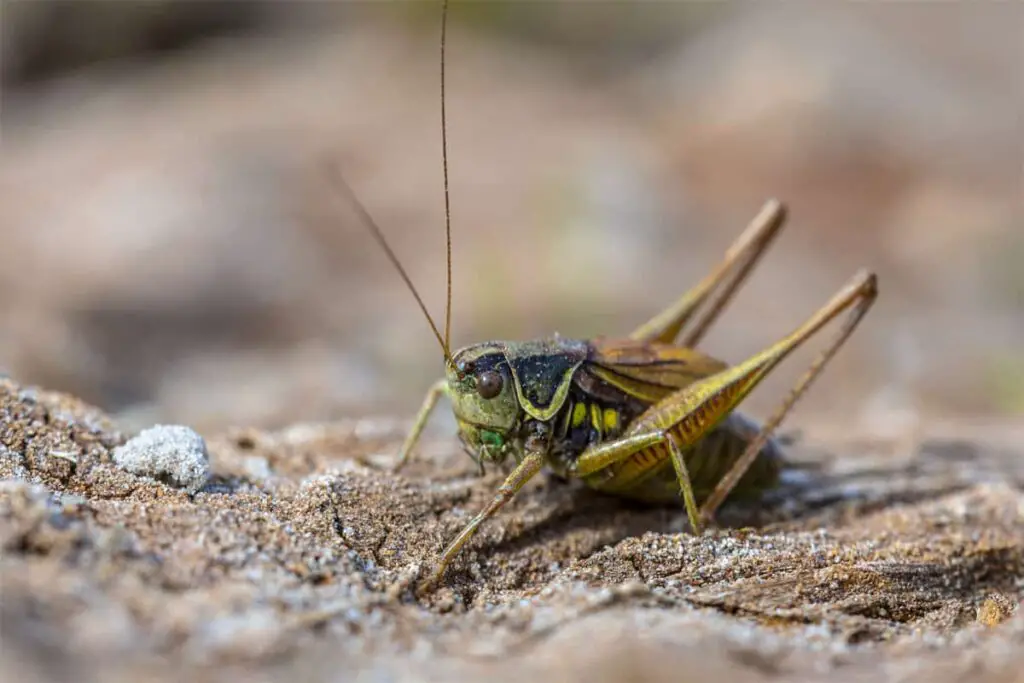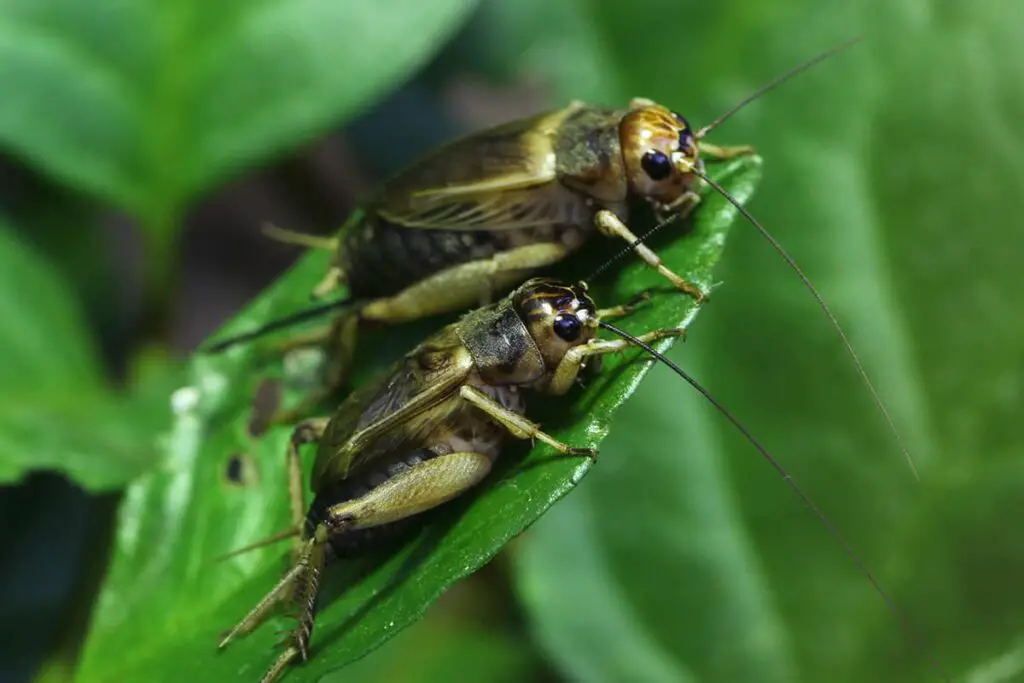Do you know what cricket eggs look like? If not, you’re in for a surprise! This blog post will show you what these eggs look like and explain their biology.
Cricket eggs are an essential part of the life cycle of crickets, and they play a crucial role in the reproduction process.
Keep reading to learn more about these fascinating eggs!
What Do Cricket Eggs Look Like?
Cricket eggs are small and oval-shaped, similar to the eggs of other insects. However, what sets cricket eggs apart is their tough outer shell.
This hard shell protects the developing embryo from predators and the elements. It makes it easier for the egg to be transported from one place to another.
When a female cricket lays eggs, she buries them in the soil or hides them among leaves or debris.
Once the eggs hatch, the young crickets, known as nymphs, will emerge and begin to feed on plants and small insects.
Over several weeks, the nymphs will molt several times as they grow larger and develop into adults.
At each growth stage, the nymphs closely resemble their adult counterparts, although they lack fully developed wings.
Once they mature, crickets can live for up to two years.
During that time, they will mate and lay their own eggs, beginning the cycle anew.
Read More: Do Crickets Need Ventilation?
How Cricket Eggs Are Used In The Reproduction Process?
Cricket eggs are an essential part of the reproduction process for these insects. The female cricket will lay eggs in a prepared area, often using an ovipositor to insert them into soil or plant matter.
Once the eggs are in place, the female will cover them with a layer of dirt or other material. The eggs will incubate for some time before hatching into nymphs.
The nymphs will undergo several molts as they grow into adults. The adult crickets will then mate, and the cycle will start anew.
Cricket eggs play a crucial role in ensuring the continuation of the cricket species.
As anyone who has ever dealt with mosquitoes can attest, these pests are not only annoying. Still, they can also carry dangerous diseases like malaria and the West Nile virus.
To control mosquito populations, many people have turned to cricket eggs as part of their strategy. When cricket eggs are added to standing water, they will hatch, and the nymphs will consume any mosquito larvae present.
This can help to reduce the number of adult mosquitoes and lower the risk of disease outbreaks.
Cricket eggs can therefore be considered a helpful tool in the fight against these harmful pests.
The Biology Of Cricket Eggs

Like all animals, crickets lay eggs. To understand how crickets eggs develop, it is necessary to have a basic understanding of biology. All animals, including humans, are made up of cells.
Cells are the building blocks of life, and they come in many different shapes and sizes. For an egg to develop, it must first be fertilized by sperm cells of male crickets.
The fertilized egg then begins to divide, forming more and more cells. Each cell is different from the others and has a specific function.
As the cells divide, they eventually form all of the different parts of the cricket’s body. The process of cell division is called mitosis.
Cricket eggs take about two weeks to hatch, and the young crickets that emerge are called nymphs. Nymphs look like miniature adults, but they lack fully developed wings.
As they mature, nymphs undergo a process known as metamorphosis, in which their bodies change and grow until they reach adulthood.
Once they have reached adulthood, crickets can live for up to two years.
Fun Facts About Cricket Eggs
Cricket eggs are one of the most fascinating things about this unique creature.
Here are some fun facts about cricket eggs that you may not know.
For starters, did you know that a single fertile female cricket can lay up to 500 eggs in her lifetime? That’s a lot of crickets! But it’s not just the quantity that’s impressive; it’s also the quality.
Cricket eggs are extremely tough and can withstand a lot of wear and tear. In fact, they’ve been known to survive being stepped on or even eaten by predators.
This is because the outer shell of a cricket egg is tough and protective. It takes 7 to 10 days for cricket eggs to hatch, and once they do, the young crickets (called nymphs) look almost identical to their adult counterparts.
The only difference is that they’re much smaller, of course. Nymphs go through several molts as they grow, shedding their skin as they get bigger.
After about 2 months, they’re fully grown and ready to start laying eggs themselves!
So there are some fun facts about how many eggs female cricket lays. Now you know more about this incredible insect and how it reproduces.
Read More: How Long Will a Cricket Live in My House?
Where Do Crickets Lay Their Eggs?
As anyone kept awake by the sound of chirping crickets knows, these tiny insects can be quite a nuisance.
But where do these noisy critters lay their eggs?
It turns out that crickets lay their eggs in the ground, depositing them in small holes that they dig with their back legs. Once the eggs are laid, the parents cover them up with dirt and move on.
The eggs hatch within a few weeks, and the baby crickets emerge from underground ready to take on the world and make some noise.
So, the next time you hear a cricket chirping in the night, just remember that there’s a good chance there are dozens of eggs nearby, just waiting to hatch.
How Do You Tell If A Cricket Is Laying Eggs?
Eggs are an essential part of the life cycle of any species, and crickets are no exception.
However, unlike many other animals, house crickets do not have a dedicated reproductive organ for laying eggs. Instead, they lay their eggs in small holes created in the ground.
As a result, it can be difficult to tell if cricket is laying eggs simply by looking at it. However, a few signs indicate that cricket is about to lay eggs.
For example, a female cricket lays eggs and often becomes more aggressive and territorial during the egg-laying process.
They may also be seen digging small holes in the ground. If you see a cricket exhibiting these behaviors, it is likely preparing to lay its eggs.
Conclusion
Cricket eggs are a fascinating part of cricket’s life cycle. These tiny eggs can withstand a lot of wear and tear, and the young crickets that hatch from them look almost identical to their adult counterparts.
Crickets lay their eggs in small holes in the ground, and the parents often cover them up with dirt once they’re done.
Keep Reading:
Where Do Dragonflies Go When It Rains?
Driven by a passion for those tiny creatures that rule our world, we at Bug Domain strive to be your go-to resource for information on insects.



